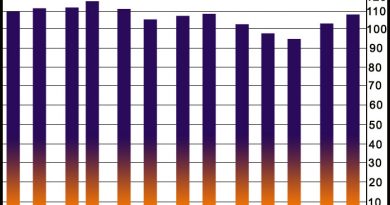U.S. Stocks Close Nearly Unchanged For Second Straight Day
Largely mirroring the performance seen in the previous session, stocks moved to the upside in early trading on Wednesday but showed a lack of direction for much of the rest of the day. The major averages once again finished the day near the unchanged line.
A late move to the upside helped the major averages close modestly higher. The Dow inched up 25.07 points or 0.1 percent to 34,600.38, the Nasdaq edged up 19.85 points or 0.1 percent to 13,756.33 and the S&P 500 crept up 6.08 points or 0.1 percent to 4,208.12.
The early strength on Wall Street partly reflected continued optimism about the outlook for the global economy following Tuesday’s upbeat manufacturing data.
Trading activity remained relatively light, however, as traders seemed wary of making significant moves amid lingering concerns about inflation.
The Labor Department’s looming monthly jobs report also kept some traders on the sidelines ahead of the release of the closely watched data on Friday.
Economists currently expect the report to show employment jumped by 664,000 jobs in May after climbing by 266,000 jobs in April. The unemployment rate is also expected to dip to 5.9 percent from 6.1 percent.
Payroll processor ADP typically releases its report on private sector employment on the Wednesday before the Labor Department report, but the data was delayed until Thursday due to the Memorial Day holiday on Monday.
While the ADP report often shows stark differences from the Labor Department report, the data could still have given traders some idea of what to expect.
Traders largely shrugged off the Federal Reserve’s Beige Book, which said the U.S. economy increased at a somewhat faster rate from early April to late May due in part to the positive effects of increased Covid-19 vaccination rates and relaxed social distancing measures.
The Beige Book, a compilation of anecdotal evidence on economic conditions in each of the twelve Fed districts, still described the pace of economic growth as moderate.
The Fed said the effects of expanded vaccination rates were most notable in consumer spending, as increased leisure travel and restaurant spending augmented ongoing strength in other spending categories.
However, several districts also noted the adverse impacts of supply chain disruptions, with manufacturers reporting that widespread shortages of materials and labor along with delivery delays made it difficult to get products to customers.
Similar challenges also affected the housing sector, where strong demand, buoyed by low mortgage interest rates, outpaced homebuilders’ capacity to build, leading some to limit sales.
The Fed acknowledged the continuing supply chain disruptions also contributed to an increase in overall price pressures since the last Beige Book in April.
Sector News
Oil service stocks once again outperformed amid the lackluster performance by the broader markets, driving the Philadelphia Oil Service Index up by 7.2 percent to its best closing level in over a year.
The continued strength among oil service stocks came as the price of crude oil saw further upside, with crude for July delivery jumping $1.11 to a new more than two-year closing high of $68.83 a barrel.
Oil producer stocks also saw some further upside, moving notably higher on the day along with commercial real estate stocks.
On the other hand, housing stocks showed a substantial move to the downside, dragging the Philadelphia Housing Sector Index down by 2 percent.
Other Markets
In overseas trading, stock markets across the Asia-Pacific region turned in a mixed performance during trading on Wednesday. Japan’s Nikkei 225 Index climbed by 0.5 percent, while China’s Shanghai Composite Index slid by 0.8 percent.
Meanwhile, the major European markets all moved to the upside on the day. While the German DAX Index edged up by 0.2 percent, the U.K.’s FTSE 100 Index and the French CAC 40 Index rose by 0.4 percent and 0.5 percent, respectively.
In the bond market, treasuries have rebounded following the pullback seen in the previous session. As a result, the yield on the benchmark ten-year note, which moves opposite of its price, fell by 2.4 basis points to 1.591 percent.
Looking Ahead
ADP’s private sector jobs report may attract attention on Thursday along with reports on initial jobless claims and service sector activity.
Source: Read Full Article


